Surface Grass Closed December 20, 1981 Demolished 28 January 1985 | Broke ground June 20, 1955 Opened 24 April 1956 Architecture firm Osborn Engineering | |
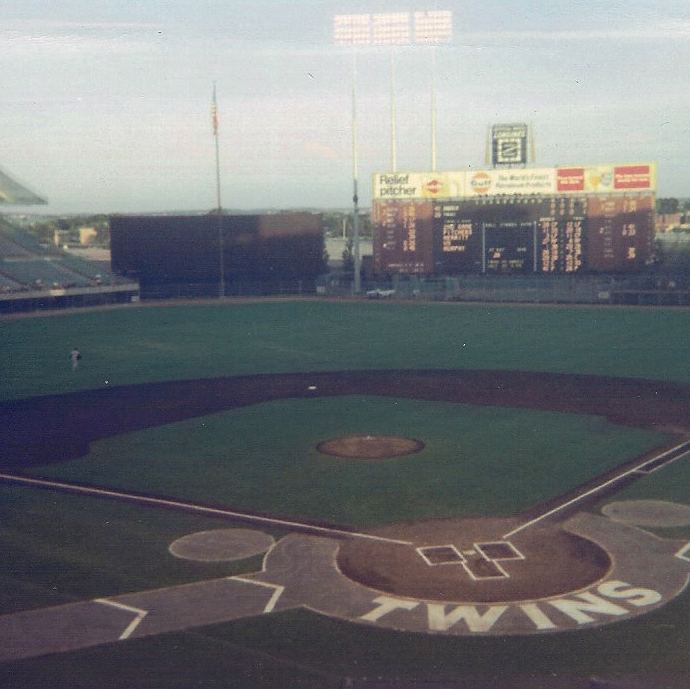 | ||
Location 8000 Cedar Avenue SouthBloomington, Minnesota Capacity Baseball: 18,200 (1956)21,000 (1957–1959)30,637 (1960–1963)40,000 (1964–1969)45,914 (1970–1972)45,921 (1973–1974)45,919 (1975–1981)Football: 41,200 (1961–1964)47,900 (1965–1970)49,784 (1971–1973)47,900 (1974–1976)48,446 (1977–1981) Field size Left Field: 343 ft (105 m)Left-Center: 365 ft (111 m)Center Field: 402 ft (123 m)Right-Center: 370 ft (110 m)Right Field: 330 ft (100 m)Backstop: 60 ft (18 m)Wall: 8 feet (2.4 m) Similar Hubert H Humphrey Metrodome, Met Center, Target Field, Griffith Stadium, Municipal Stadium | ||
Metropolitan stadium 1974
Metropolitan Stadium (often referred to as "the Met", "the Ice Palace" when the Minnesota Vikings played, "Met Stadium", or now "the Old Met" to distinguish from the Metrodome) was a sports stadium that once stood in Bloomington, Minnesota, just outside Minneapolis. The Minneapolis Millers minor league baseball team played at Met Stadium from 1956 to 1960. The Minnesota Twins and the Minnesota Vikings then played at the "Met" from 1961 to 1981. The North American Soccer League soccer team Minnesota Kicks also played there from 1976 to 1981.
Contents
- Metropolitan stadium 1974
- Metropolitan stadium last game vikings chiefs
- Origins and construction
- Baseball and football
- Soccer and other events
- Final years and demise
- After the Met
- Photo gallery abandonment
- References
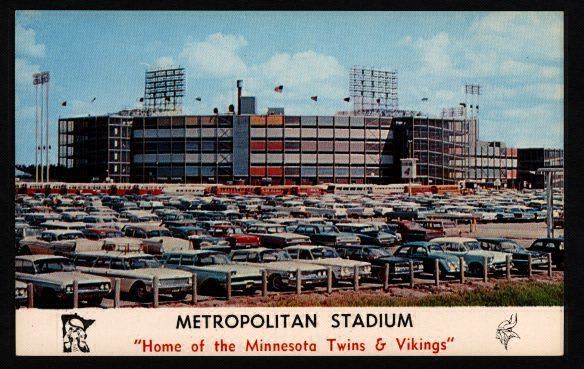
The area where the stadium once stood is now the site of the Mall of America.
Metropolitan stadium last game vikings chiefs
Origins and construction
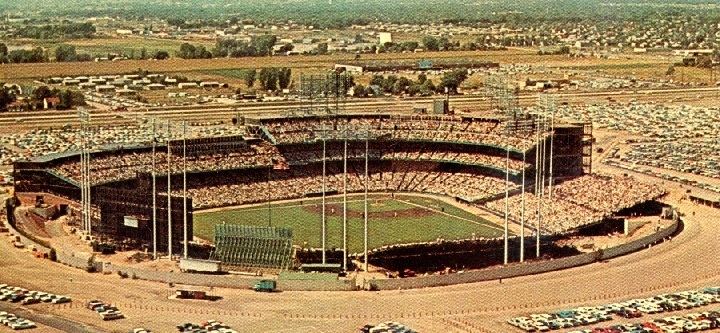
Beginning in 1953, inspired by the Boston Braves' move to Milwaukee, Gerald Moore, the president of the Minneapolis Chamber of Commerce, led the drive to lure a Major League team to Minnesota by constructing a modern stadium built to Major League specifications. After the rejection of numerous sites, a stadium committee appointed by Moore approved a 160-acre (0.65 km2) plot of farmland in Bloomington. The stadium would replace Nicollet Park as the home of the American Association's Minneapolis Millers. As the site in Bloomington was approximately equidistant from the downtowns of Minneapolis and St. Paul, it was thought this would be the best location for a prospective Major League team.
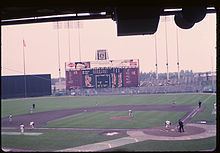
After a plan by architects Thorshov & Cerny won approval, groundbreaking was scheduled to begin on June 20, 1955. The construction was almost delayed, however, when the owners of the property on which the stadium would be built on began a protest, claiming they had not yet been paid. One of these owners created a barricade of farm equipment along his property line that ran directly through where the stadium's infield would be. The dispute was settled in time for the groundbreaking to move forward as planned. Many spectators and dignitaries attended the groundbreaking, including Minneapolis mayor Eric G. Hoyer and several members of the Minneapolis Millers.
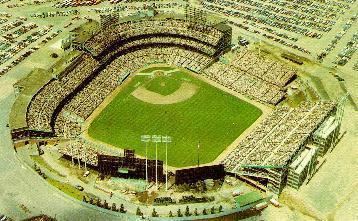
On February 7, 1956, an accident occurred on the construction site when a portable heater used to cure concrete exploded in the stadium's basement. After $50,000 of repairs and a three-week delay in construction, Metropolitan Stadium opened in time to hold its first game, a minor league contest between the Millers and the Wichita Braves on April 24 of that year. (At the time of its opening, the stadium still lacked an official name; the park was not named until a July announcement declaring it "Metropolitan Stadium".)
In the 1950s, major league owners Calvin Griffith and Horace Stoneham called the stadium the finest facility in the minors; Stoneham added that "there were not two better" major league stadiums of the time (although not specifying which specific two he thought were the Met's equal) Indeed, the Met's primary purpose was to attract a big-league team to the area. The Millers were then the top farm team of Stoneham's New York Giants, and there was some hope or expectation that the Giants might relocate there. Under major league rules of the time, the Giants owned the major league rights to the Minneapolis area. Negotiations were also held with the Cincinnati Reds, Cleveland Indians, Philadelphia Athletics and Washington Senators. However, the Giants chose to follow the Brooklyn Dodgers to the west coast at the urging of Dodgers owner Walter O'Malley, who owned the Millers' crosstown rivals, the St. Paul Saints. San Francisco had long been home to the Pacific Coast League's San Francisco Seals, the top farm team of the Boston Red Sox. As part of the deal, the Millers' parent team then became the Red Sox, who had no plans to move anywhere.
Multiple exhibition games featuring Major League teams were held at the Met at this time; a game between the Detroit Tigers and Cincinnati Reds was held at the Met in 1957, and a matchup between the Senators and the Philadelphia Phillies was held shortly after the 1958 All-Star break. The latter game brought 15,990 fans to the stadium, including Calvin Griffith, who described the stadium as "terrific."
Baseball and football
In October 1960, Calvin Griffith announced that his Washington Senators would move to Metropolitan Stadium and later became the Minnesota Twins. The Twins played their first home game on April 21, 1961 with a loss to the new Washington Senators (now the Texas Rangers).[1] The Millers and their perennial crosstown rival St. Paul Saints were then promptly folded by Major League Baseball. To ready the stadium for the Twins, a $9 million renovation increased the seating capacity from about 22,000 to over 30,000 by the completion of the Twins' inaugural season. During the Twins' first 10 seasons at the Met, they outdrew the average American League team each year.
The National Football League (NFL) was also interested in placing a team at the Met. Conversations were had with Violet Bidwill Wolfner, owner of the Chicago Cardinals, about moving her team to the stadium. The Cardinals moved two of their regular season home games against the Philadelphia Eagles (October 25) (att: 20,112) and New York Giants (November 22) (att: 26,625) to Bloomington for the 1959 NFL season. A preseason football game was held each year at the Met from 1956 to 1960.
Finally, the Met got a football team when the American Football League announced Minneapolis- St. Paul as one of its charter cities for the 1960 AFL season. However, the NFL persuaded the team's owners to pull out of the AFL in January 1960 and join the NFL as an expansion team in 1961. The NFL team was later named the Minnesota Vikings. As it turned out, the year's delay worked to the Vikings' benefit, as by then the Twins had moved in and the Met had been expanded to befit its status as a big-league stadium. (The Chicago Cardinals, after playing two games in Bloomington in 1959, announced in March 1960 that they were moving to St. Louis.)
The Met was often considered a substandard venue for football. The gridiron ran from around third base to right field, with barely enough room to fit the playing field and end zones. Wooden bleachers were brought onto the field during football season to bring fans closer to the game. For 1965, a large double-decked grandstand was installed in left field to replace the temporary wooden bleachers. The left-field grandstand was actually paid for by the Vikings in return for reduced rent; this location was prime sideline seating in the football configuration. This left the Met with the unique configuration of a double deck in left field, and bleachers behind third base. The big left field stand was originally planned to be capable of sliding toward or away from the gridiron (as Denver's Mile High Stadium later would be), but that part of the project was never realized.
The park had a skeletal feel, and it was obvious that it had once been a minor league baseball stadium. For instance, fans in the bleachers literally had to leave the stadium to get to the grandstand. The bleachers did not exist when the Met was originally built, and no concourse was ever built to connect them to the rest of the stadium. Unlike most multipurpose stadiums built during this time, there were very few bad seats for baseball. The stadium was built using cantilever construction for the overhanging decks, eliminating posts that blocked the fans' view. It was well known as a hitter's park; its short foul lines—343 to left, 330 to right—were particularly friendly to pull hitters such as Harmon Killebrew. The 330-foot (100 m) marker in right was actually closer to right-center, leading to speculation that right field was even closer. Since the Met was built in 1956, however, this would not have been a problem for the Twins; baseball required all parks built after 1958 to have foul lines of at least 325 feet (99 m).
The Met provided an overwhelming home-field advantage for the Vikings late in the season and in the playoffs due to Minnesota's famously cold temperatures. The Vikings played 10 playoff games at the Met and lost only three of them.
In 1965, both the Major League All-Star Game and the World Series were played at Metropolitan Stadium, one of the few times that coincidence has happened since the former event was inaugurated in 1933. (Game 7 of that year's World Series drew 50,596 fans to the Met, the only time a baseball crowd exceeded 50,000 and the biggest-ever attendance for baseball at the stadium.) The Vikings hosted the 1969 NFL Championship Game at the stadium.
Soccer and other events
Metropolitan Stadium was the home of the Minnesota Kicks soccer team from 1976 until the team folded in November 1981. The Kicks, members of the North American Soccer League, were highly anticipated in Minnesota and had to delay their first game at the Met by 15 minutes to accommodate the large crowd waiting to buy tickets. To help speed things along, the Kicks' owners let two thousand fans enter the stadium for free. An NASL attendance record was set one month later, when Pelé and the New York Cosmos drew 46,164 fans to Metropolitan Stadium. Large crowds continued for the Kicks, who drew 41,505 for that year's opening playoff game. Four days later, another record was set when 49,571 fans came to see the Kicks defeat San Jose, 3-1. The team enjoyed great success in their first four seasons in Minnesota, winning a division title each year. Attendance dipped toward the end of the franchise's history, however, with an average of 16,605 per game in 1981, their final season. The size of the field for soccer games was 100 by 72 yards 1976–78 and 104 by 72 yards 1979–81.
The Met also hosted multiple concerts. On August 21, 1965, The Beatles played in front of 25,000 frenzied fans as part of their 1965 North American Tour. On August 1, 1978, a concert featuring the Eagles, the Steve Miller Band, and Pablo Cruise drew a stadium-record 65,000 fans. The Allman Brothers Band played the Met on June 24, 1979.
Numerous wrestling matches were held at Metropolitan Stadium, including contests featuring Hard Boiled Haggerty, Bob Geigel, Wilbur Snyder, Kay Noble, Lord Littlebrook, Verne Gagne, Gene Kiniski, Rene Goulet, Larry Hennig, Hans Schmidt, Mad Dog Vachon and Dick the Bruiser.
Final years and demise
The Met's fate was essentially sealed when, as part of the AFL-NFL Merger, the NFL declared that stadiums smaller than 50,000 were inadequate for its needs; at its height the Met only seated 48,700 for football. However, the Vikings would not even consider playing at the University of Minnesota's Memorial Stadium, and demanded a brand-new stadium as a condition of staying in town. At one point, the city of Bloomington had plans to place a dome over Metropolitan Stadium, or build a new football stadium located between the Met and the Met Center, which had opened in 1967 just north of the Met. Since football-only stadiums were not seen as viable at the time, the Twins decided not to renew their lease at the Met after the 1981 season. This accelerated the push for construction of a new stadium, the Hubert H. Humphrey Metrodome, which was completed in 1981.
However, it is very likely that a new stadium would have been needed in any event, as the Met was not well maintained. By the park's final season, railings in the grandstand's third deck had become a major safety hazard. Additionally, players had begun to complain about the quality of the field; the infield in particular was considered the worst in the majors. Rumors abounded that the Metropolitan Sports Facilities Commission, which by then had taken over the stadium from the city of Minneapolis, had deliberately let the Met go to seed in order to aid the push for the Metrodome.
The Minnesota Kicks' last regular season game at Met Stadium was a 2-1 victory over the Dallas Tornado on August 19, 1981. The team's last game at the Met was a 1-0 shoot out play off victory against the Tulsa Roughnecks on August 26, 1981. The team's last game played was a home playoff loss 3-0 to the Fort Lauderdale Strikers on September 6, 1981. The game was moved to the University of Minnesota's Memorial Stadium due to a scheduling conflict with the Twins.
The Twins played their last game at the Met on September 30, 1981, losing to the Kansas City Royals 5-2 on a rainy afternoon. The night before the final game, home plate was stolen, and after the final game ended, hundreds of fans gathered on the field, searching (mostly unsuccessfully) for mementoes.
Finishing the trifecta, the Vikings played their last game on December 20, 1981, dropping a 10-6 decision to the Kansas City Chiefs. Fans, sensing that this was the final game of any sort at the stadium, were more determined to claim souvenirs. In preparation, the Vikings tripled their security force for the contest. In the game's final minutes, many of the 41,110 fans in attendance began dismantling seats and bleachers, and thousands stormed the field once the game ended. The goal posts were torn down, pieces of sod from the field were dug up, and speakers and lightbulbs on the scoreboard were removed. Hundreds of injuries were reported, mostly minor scrapes and bruises but also multiple head injuries sustained during the melee.
Met Stadium was officially abandoned when the Vikings and the Twins moved to the Metrodome in January 1982 and the Kicks folded after the 1981 soccer season. For the next 3 years, Met Stadium sat unused, decaying and highly vandalized. Demolition kickoff for Metropolitan Stadium started on January 28, 1985 and continued for the next 4 months. After the rubble was cleared, the lot sat vacant for several years, although the nearby Met Center continued to provide entertainment for hockey fans.
After the Met
The Mall of America, which opened in 1992, stands on the site of what is now nostalgically called "the Old Met." A brass plaque in the shape of home plate, embedded in the floor in the northwest corner of Nickelodeon Universe, commemorates the site's days as a sports venue by marking where home plate once sat. Near the opposite corner, mounted high on the wall, is a red stadium chair denoting the precise landing spot (including elevation) of Harmon Killebrew's 520-foot (160 m) home run, a blast to the upper deck in deep left-center field on June 3, 1967. This was the longest homer Killebrew ever hit, and the longest ever hit in Metropolitan Stadium. Unlike the chair at the Mall, the Met's outfield seating featured green bleacher-style benches.
For a time, there was talk of building a new park for the Twins on the old Met site that would be connected to the Mall of America. However, the terms of the agreement in which the land was sold to Triple Five Group, owners of the Mall of America, do not allow another stadium to be built on the site. Even without this to consider, the site is now directly in a flight path for Minneapolis–St. Paul International Airport.
The old flagpole at the stadium was purchased by the Minneapolis/Richfield American Legion Post when the stadium was razed. The pole was sold back to the Twins and restored in 2010; it was then placed in the plaza at Target Field.
Photo gallery: abandonment
A series of photographs taken in the mid-1980s during Metropolitan Stadium's abandonment.
